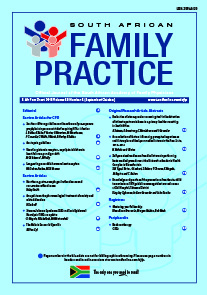Evaluation of a two-question screening tool in the detection of intimate partner violence in a primary healthcare setting in South Africa
Abstract
Introduction: Intimate partner violence has been recognised globally as a human rights violation. It is universally underdiagnosed and the institution of timeous multi-faceted interventions has been noted to benefit intimate partner violence victims. Currently the concept of using a screening tool to detect intimate partner violence has not been widely explored in a primary healthcare setting in South Africa, and for this reason the current study was undertaken. The objectives of this study were: (1) to determine the operating characteristics of a two-question screening tool for intimate partner violence (Women Abuse Screening Tool–short); and (2) to estimate the prevalence of intimate partner violence among women attending an outpatient department, using a validated questionnaire (Women Abuse Screening Tool). Methods: A cross-sectional study was conducted prospectively at the outpatient department of a primary care hospital, with systematic sampling of one in eight women over a period of three months. Participants were asked about their experience of intimate partner violence during the past 12 months. The Women Abuse Screening Tool–short was used to screen patients for intimate partner violence. To verify the result of the screening, women were also asked the remaining questions from the full Women Abuse Screening Tool. Results: Data were collected from 400 participants, with a response rate of 99.3%. Based on the results for the Women Abuse Screening Tool, the prevalence of intimate partner violence in the sample was 32%. The Women Abuse Screening Tool–short was shown to have a sensitivity of 45.2% and specificity of 98%. Conclusion: With its high prevalence, intimate partner violence is a health problem at this facility. The Women Abuse Screening Tool–short lacks sufficient sensitivity and therefore is not an ideal screening tool for this primary care ambulatory setting. The low sensitivity can be attributed to the participants’ understanding of the screening questions, which utilise Eurocentric definitions of intimate partner violence. Improvement in the sensitivity of the Women Abuse Screening Tool–short in this setting may be achieved by lowering the threshold for a positive result. (Full text of the research articles are available online at www.medpharm.tandfonline.com/ojfp) S Afr Fam Pract 2016; DOI: 10.1080/20786190.2016.1223796
Section
Original Research
By submitting manuscripts to SAFP, authors of original articles are assigning copyright to the South African Academy of Family Physicians. Copyright of review articles are assigned to the Publisher, Medpharm Publications (Pty) Ltd, unless otherwise specified. Authors may use their own work after publication without written permission, provided they acknowledge the original source. Individuals and academic institutions may freely copy and distribute articles published in SAFP for educational and research purposes without obtaining permission.

